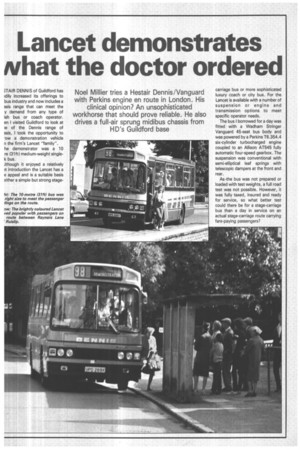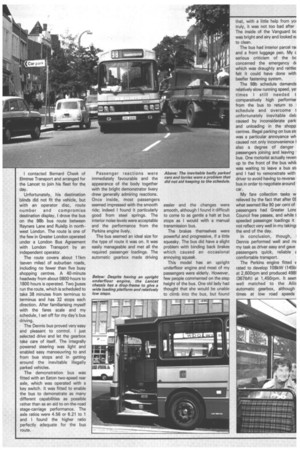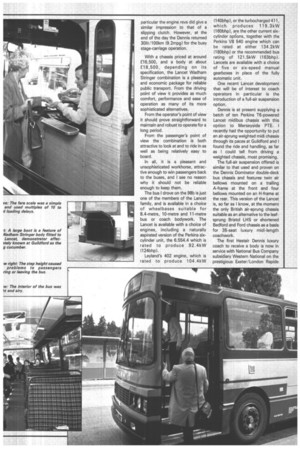Lancet demonstrates what the doctor ordered
Page 35

Page 36

Page 37

Page 38

If you've noticed an error in this article please click here to report it so we can fix it.
Noel Millier tries a Hestair Dennis/Vanguard with Perkins engine en route in London. His clinical opinion? An unsophisticated workhorse that should prove reliable. He also drives a full-air sprung midibus chassis from HD's Guildford base
;TAIR DENNIS of Guildford has idily increased its offerings to bus industry and now includes a ssis range that can meet the y demand from any type of ish bus or coach operator. en I visited Guildford to look at ie of the Dennis range of ssis, I took the opportunity to .ow a demonstration vehicle n the firm's Lancet "family".
he demonstrator was a 10 re i31ft) medium-weight singlek bus.
,Ithough it enjoyed a relatively .rt introduction the Lancet has a e appeal and is a suitable basis either a simple but strong stage carriage bus or more sophisticated luxury coach or city bus. For the Lancet is available with a number of suspension or engine and transmission options to meet specific operator needs.
The bus I borrowed for a day was fitted with a Wadham Stringer Vanguard 45-seat bus body and was powered by a Perkins T6.354.4 six-cylinder turbocharged engine coupled to an Allison AT545 fully automatic four-speed gearbox. The suspension was conventional with semi-elliptical leaf springs with telescopic dampers at the front and rear.
As .the bus was not prepared or loaded with test weights, a full road test was not possible. However, it was fully taxed, insured and ready for service, so what better test could there be for a stage-carriage bus than a day in service on an actual stage-carriage route carrying fare-paying passengers? I contacted Bernard Cheek of Elmtree Transport and arranged for the Lancet to join his fleet for the day.
Unfortunately, his destination blinds did not fit the vehicle, but with an operator disc, route number and compromise destination display, I drove the bus on the 98b bus route between Rayners Lane and Ruislip in northwest London. The route is one of the few in Greater London operated under a London Bus Agreement with London Transport by an independent operator.
The route covers about 11km (seven miles) of suburban roads, including no fewer than five busy shopping centres. A 40-minute headway from about 0800 hours to 1800 hours is operated. Two puses run the route, which is scheduled to take 38 minutes from terminus to terminus and has 32 stops each direction, After familiarising myself with the fares scale and my schedule, I set off for my day's bus driving.
The Dennis bus proved very easy and pleasant to control. I just selected drive and let the gearbox take care of itself. The integrally powered steering was light and enabled easy manoeuvring to and from bus stops and in getting around the inevitable illegally parked vehicles.
The demonstration bus was fitted with an Eaton two-speed rear axle, which was operated with a key switch. It was fitted to enable the bus to demonstrate as many different capabilities as possible rather than as an aid to on-the-road stage-carriage performance. The axle ratios were 4.56 or 6.21 to 1 and I found the higher ratio perfectly adequate for the bus route. Passenger reactions were immediately favourable and the appearance of the body together with the bright demonstrator livery drew generally admiring reactions. Once inside, most passengers seemed impressed with the smooth ride; indeed I found it particularly good from steel springs. The interior noise levels were acceptable and the performance from the Perkins engine lively.
The bus seemed an ideal size for the type of route it was on. It was easily manageable and met all the required passenger loadings. The automatic gearbox made driving easier and the changes were smooth, although I found it difficult to come to as gentle a halt at bus stops as I would with a manual transmission bus.
The brakes themselves were powerful and progressive, if a little squeaky. The bus did have a slight problem with binding back brakes which caused an occasional annoying squeak.
This model has an upright underfloor engine and most of my passengers were elderly. However, few people commented on the step height of the bus. One old lady had thought that she would be unable to climb into the bus, but found that, with a little help from yoi truly, it was not too bad after ; The inside of the Vanguard bc was bright and airy and looked to clean.
The bus had interior parcel ra( and a front luggage pen. My c serious criticism of the bc concerned the emergency d( which was draughty and rattlec felt it could have done with beefier fastening system.
The 98b schedule demands relatively slow running speed, yei times I still needed t comparatively high .performar from the bus to return to 1 schedule and overcome t unfortunately inevitable delz caused by inconsiderate parki and unloading in the shoppi centres. Illegal parking on bus stc was a particular annoyance wh caused not only inconvenience 1 also a degree of danger passengers joining and leaving bus. One motorist actually revere up to the front of the bus whilf was waiting to leave a bus stc and I had to remonstrate with driver to avoid having to reverse bus in order to negotiate around car.
My fare collection tasks w relieved by the fact that after OE what seemed like 90 per cent of • passengers had Greater Lonc Council free passes, and while t speeded passenger loadings it not reflect very well in my taking; the end of the day.
In conclusion, though, 1 Dennis performed well and ME my task as driver easy and gave passengers quick, reliable comfortable transport.
The Perkins engine fitted v rated to develop 108kW (145b1 at 2,600rpm and produced 4981 i3671bft) at 1,450rpm. It seen well matched to the Allis automatic gearbox, although times at low road speeds particular the engine revs did give a similar impression to that of a slipping clutch. However, at the end of the day the Dennis returned 301it/100km (9.2mpg) for the busy stage-carriage operation.
With a chassis priced at around £16,500, and a body at about £18,500, depending on its specification, the Lancet Wadham Stringer combination is a pleasing and economic package for reliable public transport. From the driving point of view it provides as much comfort, performance and ease of operation as many of its more sophisticated alternatives.
From the operator's point of view it should prove straightforward to maintain and robust to operate for a long period.
From the passenger's point of view the combination is both attractive to look at and to ride in as well as being relatively easy to board.
In all, it is a pleasant and unsophisticated workhorse, attractive enough to win passengers back to the buses, and I see no reason why it should not be reliable enough to keep them.
The bus I drove on the 98b is just one of the members of the Lancet family, and is available in a choice of wheelbases suitable for 8.4-metre, 10-metre and 11-metre bus or coach bodywork. The Lancet is available with a choice of engines, including a naturally aspirated version of the Perkins sixcylinder unit, the 6.554.4 which is rated to produce 92.4kW (124bhp).
Leyland's 402 engine, which is rated to produce 104 .4kW (140bhp), or the turbocharged 411, which produces 119.3kW (160bhp), are the other current sixcylinder options, together with the Perkins V8 540 engine which can be rated at either 134.2kW (180bhp) or the recommended bus rating of 121.5kW (163bhp). Lancets are available with a choice of five or six-speed manual gearboxes in place of the fully automatic unit.
One recent Lancet development that will be of interest to coach operators in particular is the introduction of a full-air suspension option.
Dennis is at present supplying a batch of ten Perkins T6-powered Lancet midibus chassis with this option to Merseyside PTE. I recently had the opportunity to put an air-sprung weighted midi chassis through its paces at Guildford and I found the ride and handling, as far as I could tell from driving a weighted chassis, most promising.
The full-air suspension offered is similar to that used and proven on the Dennis Dominator double-deck bus chassis and features twin air bellows mounted on a trailing A-frame at the front and four bellows mounted on an H-frame at the rear. This version of the Lancet is, so far as I know, at the moment the only British air-sprung chassis suitable as an alternative to the leafsprung Bristol LHS or shortened Bedford and Ford chassis as a basis for 35-seat luxury midi-length coachwork.
The first Hestair Dennis luxury coach to receive a body is now in service with National Bus Company subsidiary Western National on the prestigious Exeter/London Rapide service. This high-floor rearengined Perkins-powered coach is one of the Dennis Falcon range of rear-engined air-sprung chassis suitable as a basis for double or single-deck bus or coach applications (see CM September 11).
Another vehicle from the same range, now starting to be delivered to operators, is the Mercedes-Benzpowered Dennis Falcon V doubledeck. I also had a chance to put an East Lancashire-bodied version of this chassis for a brief test drive in Guildford. Powered by the Mercedes-Benz 0M421 V6 engine, which develops 140kW (188bhp) at 2,000rpm, the bus features an almost flat lower saloon floor to give the maximum possible seating capacity allowed by its underfloor straight-engine. The bus was a Hestair Dennis demonstrator and was unladen, so driving impressions could not be received in depth. However, my immediate reaction was favourable and, like the established and proven Dennis Dominator, this model was easy to drive with its Voith D851 fully automatic gearbox, and was quiet and rode well. By using the compact but powerful V engine Dennis has simplified the drive-line arrangement and reduced the engine intrusion into the usable saloon space. As a result the bus is simpler and roomier and this could result in higher potential revenue earning capabilities coupled with increased reliability and reduced cost.
It was only in 1977 that the first of the current generation of Hestair Dennis buses, the Dominator, appeared, and the range has already been increased as new models are developed, using techniques and designs to a great extent proven with the Dominator.
The Lancet bus in particular is an unassuming vehicle that should prove of considerable interest to operators fighting to maintain a stage-carriage presence or looking to take advantage of the opportunities for competition allowed by the 1980 Transport Act.
The Wadham-Stringer Vanguard bus in particular could prove a particularly useful addition to a fleet where stage-carriage work could be complemented with contract and private-hire work over shorter distances.
The body is good looking and can provide the right appeal and comfort, although the Dennis I tried, with its bus-type seating not suitable for longer-distar work. The Wadham-Stringer included a large boot which co be useful for certain private hir including station transfers.
The Vanguard body is of si structure and is treated protection against the possibilit\ corrosion. Being of a mock design, Vanguards are available meet a wide variety specifications on a wide variety chassis from midi to 12m (41 lengths, and in basic bus to se coach interior trim levels.
From the chassis point of v with the engine, suspension ■ transmission combination I tri the Lancet is well suited to sta carriage operation as its prim role. However, its ride and handl capabilities and maximum speec around 90km th (60mph) give it flexibility to be a multi-purp workhorse.
With air suspension and mar transmission, it could becorrit premium luxury coach, although long-distance high-speed operat Dennis is developing a big brot to the Lancet the Lance. 1 premium heavyweight chassis be available with a choice of enE and transmission options incluc the horizontally and highly regan Gardner 6H LXCT engine and V( D854 gearbox.


















































































































